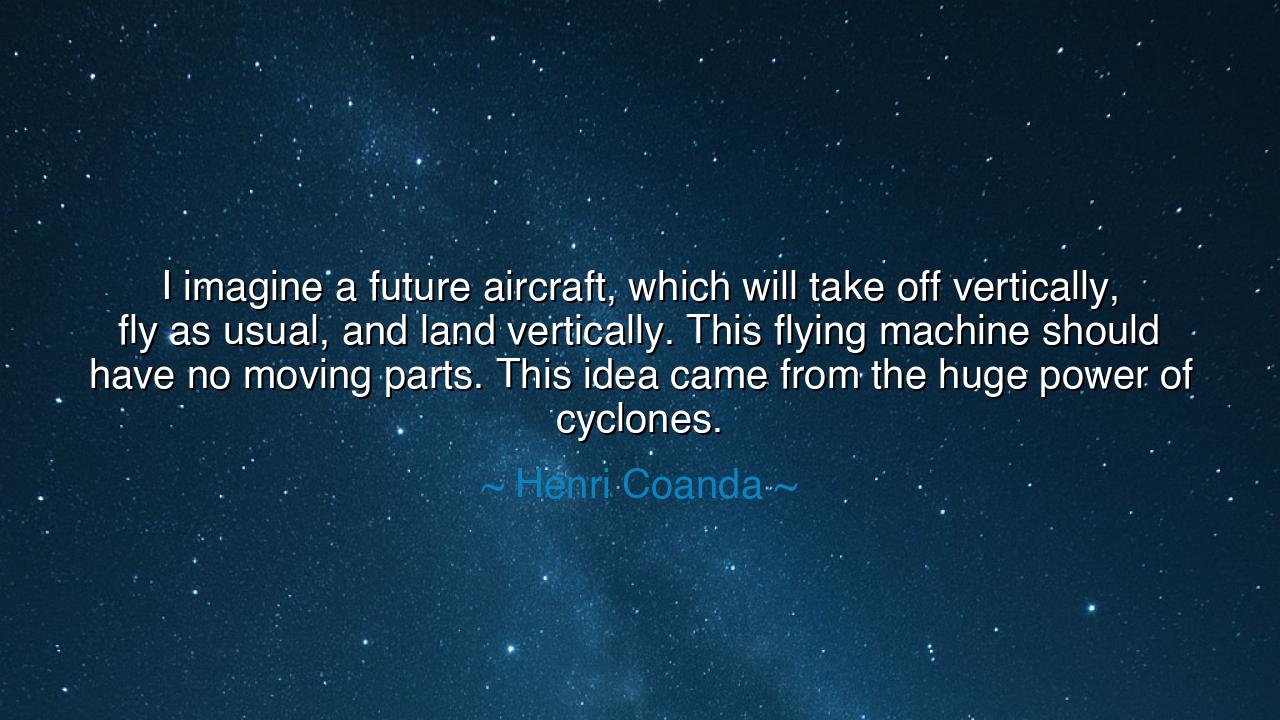
I imagine a future aircraft, which will take off vertically, fly
I imagine a future aircraft, which will take off vertically, fly as usual, and land vertically. This flying machine should have no moving parts. This idea came from the huge power of cyclones.






"I imagine a future aircraft, which will take off vertically, fly as usual, and land vertically. This flying machine should have no moving parts. This idea came from the huge power of cyclones." With these words, Henri Coanda gazes into the future, envisioning a world where the laws of flight are rewritten, and technology is inspired by the raw, untamed forces of nature. His vision—bold, imaginative, and far ahead of its time—spoke of an aircraft that defied the conventional. A machine that, like a cyclone, would harness the very power of nature’s forces, flying with grace, strength, and efficiency, yet without the complex mechanics of conventional aircraft. Coanda’s brilliance was in seeing not just what was, but what could be, through the lens of nature's power and innovation.
The cyclone, that fierce and awe-inspiring force of nature, became the wellspring of Coanda's idea. Its ability to lift, propel, and turn with seemingly effortless power sparked in him the understanding that flight need not be a battle against the elements, but a harmonious interaction with them. Like the cyclone's invisible power, Coanda's machine would tap into the forces of aerodynamics and fluid dynamics, turning them to its advantage. He foresaw a future where flight was not dictated by cumbersome, moving parts but was propelled by the unseen, yet powerful, forces of air itself.
Consider the ancient Greek philosopher Archimedes, who, while immersed in the study of geometry and buoyancy, made discoveries that defied the limitations of his time. Archimedes famously declared, "Give me a place to stand and with a lever I will move the world." Like Coanda, Archimedes saw potential in the fundamental forces of nature, and his understanding allowed him to accomplish feats that others thought impossible. Coanda, too, was inspired by the vast forces that shape our world, using them to imagine an aircraft that transcended the limitations of conventional flight.
This visionary idea was more than just a technical innovation; it was a challenge to the established limits of human ingenuity. Coanda’s aircraft would not be a mere machine; it would be an embodiment of human creativity and imagination. It spoke of a future where science, inspired by nature, could create technology that worked in harmony with the environment rather than against it. Just as Leonardo da Vinci envisioned flying machines centuries before they were realized, Coanda’s thoughts were a step forward in humanity's quest to conquer the skies. Innovation, after all, has always been the art of seeing what others cannot see and daring to believe in the possibility of the impossible.
In this vision of flight, we see the lesson that creativity and observation of nature are the keys to groundbreaking progress. Coanda did not start from a place of desperation or mere mechanical desire; instead, he drew inspiration from the very elements that shaped the earth—the winds, the storms, and the cyclones that swirl in the sky. Like the ancient mariners who navigated the seas by observing the stars, Coanda sought wisdom from nature’s forces to create something that had never existed before. His idea teaches us that we, too, can find solutions to our most difficult challenges by observing and understanding the world around us.
The lesson here is clear: True innovation is not merely about creating something new, but about understanding and working with the natural forces that shape our world. Coanda's machine was not just a flying vehicle; it was a symbol of human potential—the ability to look at the world and say, "What if?" This is the mindset that sparks progress. In our own lives, we must not simply accept the limitations of the present moment. We must ask ourselves, "What if we embraced the forces around us? What if we dared to see the potential in things previously thought impossible?"
Thus, let us all be inspired by Henri Coanda's vision, to not only innovate but to look deeply into the natural world for the answers we seek. Just as the cyclones draw their power from the atmosphere itself, so too can we draw our strength from the world around us, finding solutions that are in harmony with nature, rather than in opposition to it. We must observe, learn, and above all, imagine. For it is in the uncharted territories of our imagination that the seeds of future greatness are sown.






AAdministratorAdministrator
Welcome, honored guests. Please leave a comment, we will respond soon